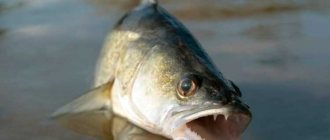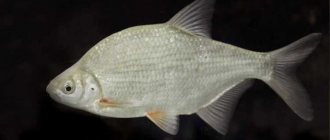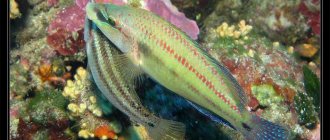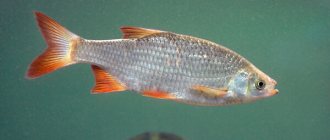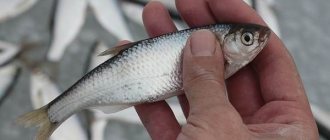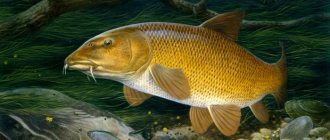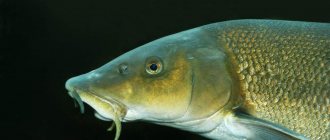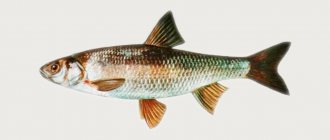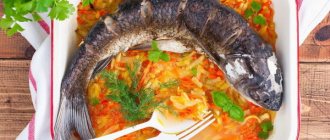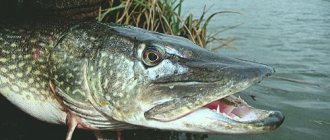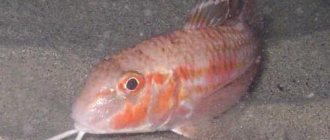Gorchak fish lives in freshwater standing or weak-current reservoirs. These small and beautiful fish have a rather exotic type of relationship with bivalves.
And their mutual influence on the diversity of the ichthyofauna of our rivers and lakes is, without exaggeration, enormous. In shape and description, the bitter fish is similar to a small multi-colored crucian carp, as can be seen from the photo below in the text.
Description and photo of bitterling
The bitterlings have a tall and short body, up to 9 cm, with large scales. Usually its length “floats” in the range from 4 to 8 cm. The sides are compressed, the head is small relative to the body, with yellow eyes and orange specks above the pupils. The mouth is semi-inferior, oblique. The pharyngeal teeth are single-rowed. The lateral line is visible only on the first 4-7 scales; in total, the fish has from 34 to 40 transverse rows.
Common mustard (from the Latin Rhodeus sericeus) belongs to the genus of ray-finned fish and the carp family (Cyprinidae).
The most common names for mustard among people are bitter, sinyavka, mustard, mustard, pukasik, etc.
The name of the fish probably comes from the bitter taste of its meat. This bitterness appeared due to the characteristics of the diet. After all, bitterlings feed mainly on bitter algae - diatoms and filamentous algae.
Another species of bitterling is common in Europe - European bitterling (Rhodeus amarus).
European bitterweed (Rhodeus amarus)
Externally, in terms of description and habits, the fish practically do not differ from each other. also belongs to the carp family.
Distributed in European countries in the river basins of France, up to the Neva in the Russian Federation.
Threats and security measures[ | ]
Captive breeding is practiced in zoos, ensuring the future of the species. The range of the golden honeyeater declined significantly after the arrival of people in the Mariana Islands. Fossil bones of this species have been found on the nearby islands of Tinian and Rota, and the bird was once found on Guam and other islands of the Mariana archipelago.
The Golden Honeyeater is now a very common bird, as a 1996 study found that Saipan had one of the highest densities of any bird at 2,095 birds/km2. It was believed that Saipan would not be able to support a large population of this bird, which, in fact, is already happening. A 2009 study, which included results from a 2007 review, found that the species had declined between 1982 and 2007, along with two other birds on Saipan, the red-fronted fantail and the nightingale warbler. All three species are insectivorous birds whose numbers have declined due to habitat loss. However, the species remains relatively abundant, with its global population currently estimated at approximately 71,997 birds.
According to the IUCN, the species is critically endangered as its numbers are expected to decline rapidly if the brown bogey, the main threat to song passerines, enters Saipan. The brown bogey is native to Australia, New Guinea and the Solomon Islands, wiping out all 12 land-based bird species after its inadvertent introduction to the nearby island of Guam. The snake has not yet arrived on Saipan, one of two islands that make up the golden honeyeater's range and largest population. The isolation of Agihan is unlikely to allow the brown boiga to enter the island, but the small population of birds is vulnerable, since the territory covers an area of 718 hectares, and the direct passage of a super typhoon could destroy it. Efforts are currently being made to breed the species in captivity and prevent the snake from entering and breeding on Saipan. Not long ago, six zoos received this species, and by 2011 it is expected to be bred. Success was not long in coming, and in 2009 at the Carolina Zoo (English)Russian. the first birds appeared. Birds born in captivity were transported to new islands. Additionally, in 2011, in hopes of establishing a breeding population, fish were transported from Saipan to the predator-free Sarigan Island. 24 birds
Spawning bitterling and shellfish
Upon reaching 2-3 years of age, bitterlings can reproduce. At this time, the size of the fish is only 3-4 cm. Males develop nuptial coloration during the spawning period. L.P. Sabaneev described the male bitterling as follows:
“His back and sides become dark purple, the side stripe becomes bright green and reaches almost to the middle of the body; the chest and belly get a pinkish tint; the fins are also made more variegated and bright (reddish in various shades with a black edge). In addition, small white warts are noticeable on both sides of the eyes and mouth.”
The females remain inconspicuous, but they grow a long ovipositor, up to 4-5 cm long.
A male bitterling fish in breeding plumage and a female with an ovipositor
The process of reproduction and the type of relationship between the bitterling fish and the bivalve mollusk pearl barley (Unio) and toothless mollusk (Anodonta) are interesting.
The male selects a group of mollusks and protects them from other males. The female, using the ovipositor, lays eggs inside the slightly open shell.
Female bitterling during spawning period
An alarmed mollusk, sensing foreign bodies inside, slams the valves and begins to intensively pump water through itself, trying to remove them. At this time, the male releases milk, which, with a current of water, enters the shell, where fertilization of the eggs occurs.
Thus, 4-5 eggs are “settled” into the shell at a time, where they turn into fry. The bitterling spawns in portions; in total, the female lays up to 280 eggs. Leaving the shell, the fry “carry away” the larvae of mollusks, helping the species spread throughout the reservoir.
Interspecific relationships between bitterling and mollusk during spawning
So, we observe interspecific relationships in the survival of fish and river shells. The bitterlings help the toothless and pearled beetles to develop new territories, and the latter provide a place for reproduction, protection and food for the offspring of the bitterlings.
Lifestyle and behavior
Gorchaki move in flocks, avoiding fast currents and heavily swampy water bodies with oxygen deficiency. The optimal habitat for the population is quiet and calm streams, creeks, and small tributaries. Due to its small size, the fish needs constant reliable shelter, which is provided by coastal vegetation thickets, stones and snags at depths of 0.5-2 meters. Gorchak constantly lives in the bottom layers or on the ground. The basic food is unicellular and colonial algae (diatoms, eudorina, gonium) and plants. To a lesser extent, the diet contains zooplankton, crustaceans, larvae, and worms.
To learn more:
Burbot: what kind of fish is this?
The main biological and feeding activity of the fish occurs during daylight hours. She spends the night in shelter, avoiding dangerous encounters with perch, burbot, pike and pike perch. But even if detected, the fish still has a chance to escape due to its high speed of movement and excellent maneuverability.
Relations within the flock and between different species of bitterlings are quite peaceful - they coexist without problems in the same territory, without showing intense food competition. Temporary difficulties in communication can arise only between males during the breeding season.
Habits of bitterling
Gorchakov are not so easy to notice in the water, unlike bleak. The fish live in schools in places where barley and toothless fish accumulate and not far from algae thickets. Moreover, in a flock of bitterlings there are about 5-6 times more females than males.
The life of a fisherman passes unnoticed and it does not show itself in any way on the pond. The fish preferentially stay on sandy-pebbly, sandy-stone bottoms. In rivers these are coastal channels and creeks; in lakes these are quiet, shallow places.
Mustards do not migrate; the place they choose once remains constant throughout their life.
Conditions for breeding in an aquarium
Gorchak is a peaceful and lively fish, which in an aquarium prefers to stay in schools in the middle and lower water horizons. Under artificial conditions, bitterling is kept in flocks in which females are the most numerous. The length of the aquarium must be at least 50 centimeters. Use sand as soil.
Gorchak is considered a rather shy fish. Therefore, it needs dense thickets in the aquarium. If the bitterling gets scared and there is no vegetation in the aquarium, the fish quickly jumps out of the water: this is how in the wild it escapes from predatory fish species for which the bitterling is their usual food. The water temperature should be within a narrow range of +18...+21 degrees Celsius, hardness - from 10 to 15, and acidity - from 7 to 7.5. Bitterweed is sensitive to the purity of water and its oxygen content, so it is necessary to replace a quarter of the water once a week, and water circulation should be moderate.
Catching bitterling
How and what to fish for bitterling fish? There is no need to prepare specially for fishing and go after a bruise. This fish is often caught in the bycatch of roach, rudd, and bleak. If you only set your mind on bitterling, the maximum that you can catch is 4-5 individuals.
Gorchak is not a poisonous fish! It has no commercial significance; it is useless in cooking, as it is small and bitter, unless you are a culinary gourmet.
Gorchak is caught with a regular float rod, mainly with black bread. An ordinary light tackle with a small hook, for example, the same as for bleak, will do. The bites of the bluefish are indecisive; often he simply sucks on the bait.
Video about bitterling fish, description and catching
Some use caught bitterlings as bait for perch and pike, but opinions vary. Some say that bitterling is exceptionally good as a live bait, others say it is useless, since the predator disdains it.
Varieties and appearance
A general description of the bitterling fish can be as follows: the body of the individuals is quite flattened laterally, it is very high. The scales are relatively large, and the lateral line is quite short. The pores on the lateral line end already at the first ten scales. The fin located on the back is long. The color and size of the fish depend on the species to which the bitterling belongs. There are different types of bitterweed:
- Ordinary;
- Ocellated, whose photo is located first under the list;
- Gorchak Light, whose photo is posted second after the list.
Ocellated bitterweed
Gorchak Light
These are the main types of fish that have become widespread. The remaining varieties have been little studied. The common bitterling is a very small fish, the length of which cannot exceed one decimeter. You can see a photo of this fish below. It is also called: bitter, mustard, garva, bitter bitter, alder, malyavka, pukasik, pukas and patsyuk.
Common bitterweed
The common mustard is silver in color, with the back being blue, the lateral line being blue, and the belly being white. The fish is very similar to juvenile crucian carp. Compare for yourself: the photo below shows a young crucian carp. Gorchak, nothing else, right? Other species may have additional shading on the body, transparent fins, and other minor differences in appearance.
Crucian fry
